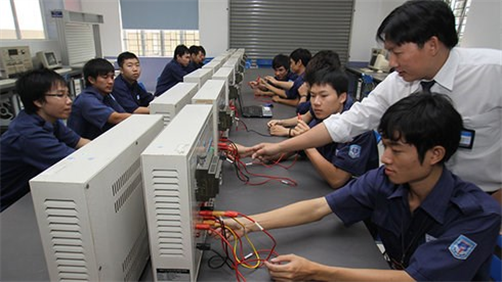(VOVWORLD) - Vietnamese businesses are coordinating with schools to fulfill their human resources needs. This trend has been particularly helpful to the country’s startup movement.
 (Photo: giaoducthoidai.com.vn) (Photo: giaoducthoidai.com.vn) |
Vietnam now has nearly 2,000 vocational training schools, 44% of which are private institutions. To make vocational training less of a gamble for students, many vocational schools have formed alliances with businesses who will commit to hiring their students after graduation.
Dr. Vu Xuan Hung, Director of the Department of Formal Training of the Directorate for Vocational Education, said businesses should help schools design their training programs and provide internships for students before graduation.
“We did a survey which shows that many businesses hire final-year students on a probationary basis as a favor because of personal relationships rather than to meet the business’s practical needs. This means ties between businesses and vocational schools are still more formal than functional,” said Hung.
Duong Ngoc Hong, a teacher at Hanoi College for Electronics and Refrigeration, says that to survive and grow, vocational schools need to make student recruitment a priority, update their teaching facilities to meet the requirements of the 4th Industrial Revolution, and work closely with businesses to ensure employment for their graduates.
Hong said: “Schools need to make full use of every relationship, especially with large companies like Samsung or Canon, to secure jobs for their graduates. With good relationships, as many as 80% of graduates can be provided a job immediately. In addition to studying at school, students should have an opportunity between semesters to gain real on-the-job experience. Schools should adapt their curriculums to prepare students to fulfill the actual current recruitment needs of businesses.”
 Making fine art products at the Hoa Son Fine Arts Company. (Photo: hoasonmn.com.vn) Making fine art products at the Hoa Son Fine Arts Company. (Photo: hoasonmn.com.vn) |
Nguyen Van Trung, Director of the Hoa Son Fine Arts Company, said: “Schools and businesses should work closely with each other to identify how many workers the enterprises need and at what levels. When the schools understand businesses’ demand, they can offer proper training and students will get employment after graduation. If the program is expanded into a chain, it will be good for both schools and businesses.”
Nguyen Thanh Nhan, Deputy Director of the Hanoi Department of Labor, Invalids and Social Affairs, said Hanoi has made students the focus of job generation, recruitment, and training efforts. Hundreds of thousands of USD invested in vocational schools since 2008 has increased the percentage of trained workers in Hanoi from 27.5% to 63%. The capital city has set a goal to train more than 200,000 workers by the end of this year.